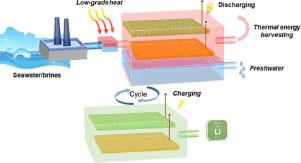Water Research ( IF 11.4 ) Pub Date : 2022-08-10 , DOI: 10.1016/j.watres.2022.118969 Yanxi Yu 1 , Ziwen Yuan 1 , Zixun Yu 1 , Cheng Wang 1 , Xia Zhong 1 , Li Wei 1 , Yuanyuan Yao 1 , Xiao Sui 1 , Dong Suk Han 2 , Yuan Chen 1

|
Extracting lithium electrochemically from seawater has the potential to resolve any future lithium shortage. However, electrochemical extraction only functions efficiently in high lithium concentration solutions. Herein, we discovered that lithium extraction is temperature and concentration dependent. Lithium extraction capacity (i.e., the mass of lithium extracted from the source solutions) and speed (i.e., the lithium extraction rate) in electrochemical extraction can be increased significantly in heated source solutions, especially at low lithium concentrations (e.g., < 3 mM) and high Na+/Li+ molar ratios (e.g., >1000). Comprehensive material characterization and mechanistic analyses revealed that the improved lithium extraction originates from boosted kinetics rather than thermodynamic equilibrium shifts. A higher temperature (i.e., 60 oC) mitigates the activation polarization of lithium intercalation, decreases charge transfer resistances, and improves lithium diffusion. Based on these understandings, we demonstrated that a thermally assisted electrochemical lithium extraction process could achieve rapid (36.8 mg g-1 day-1) and selective (51.79% purity) lithium extraction from simulated seawater with an ultrahigh Na+/Li+ molar ratio of 20,000. The integrated thermally regenerative electrochemical cycle can harvest thermal energy in heated source solutions, enabling a low electrical energy consumption (11.3–16.0 Wh mol-1 lithium). Furthermore, the coupled thermal-driven membrane process in the system can also produce freshwater (13.2 kg m-2 h-1) as a byproduct. Given abundant low-grade thermal energy availability, the thermally assisted electrochemical lithium extraction process has excellent potential to realize mining lithium from seawater.
中文翻译:

从模拟海水中热辅助高效电化学锂提取
从海水中电化学提取锂有可能解决未来的锂短缺问题。然而,电化学萃取仅在高锂浓度溶液中有效。在这里,我们发现锂的提取与温度和浓度有关。在加热的源溶液中,特别是在低锂浓度(例如, < 3 mM)下,电化学提取中的锂提取容量(即从源溶液中提取的锂的质量)和速度(即锂提取速率)可以显着提高和高 Na + /Li +摩尔比(例如, >1000)。综合材料表征和机械分析表明,改进的锂提取源于增强的动力学而不是热力学平衡变化。较高的温度(即60 o C)减轻了锂嵌入的活化极化,降低了电荷转移电阻,并改善了锂的扩散。基于这些认识,我们证明了热辅助电化学锂提取工艺可以实现从模拟海水中快速(36.8 mg g -1 day -1)和选择性(51.79%纯度)的超高Na + /Li +锂提取。摩尔比为 20,000。集成的热再生电化学循环可以在热源解决方案中收集热能,从而实现低电能消耗(11.3-16.0 Wh mol -1锂)。此外,系统中的耦合热驱动膜工艺还可以产生淡水(13.2 kg m -2 h -1)作为副产品。鉴于丰富的低品位热能可用性,热辅助电化学锂提取工艺具有从海水中开采锂的巨大潜力。









































 京公网安备 11010802027423号
京公网安备 11010802027423号